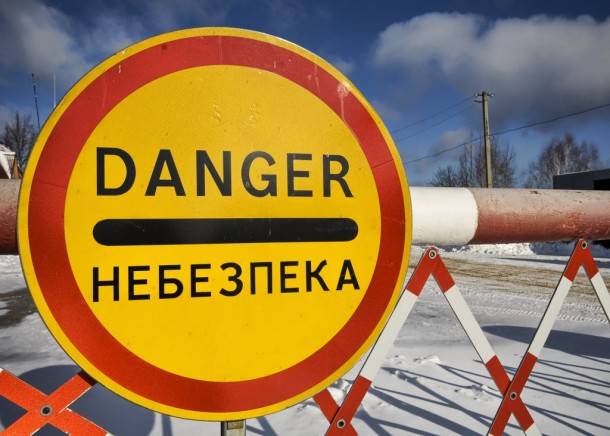UKRAINE / RUSSIA. The ongoing conflict between Ukraine and Russia, sparked by the Euromaidan protests in Kiev exactly one year ago, now feels like a proxy of the Cold War. Vladimir Putin jabs regularly at Western leaders at international summits; Ukrainian and Russian military forces eye each other across the border (or more accurately, within Ukraine’s border); and Western allies have suspended visas, imposed economic sanctions, and warned against further Russian aggression.
How do we explain this conflict? Thus far, it has largely been characterized in realist terms: Ukraine is a hotly-contested borderland between Europe and Russia, a battleground of naked state interests. Kiev’s growing military, political, and economic ties with the West violate Russia’s traditional sphere of influence. Russia is threatened on multiple sides: militarily by the expansion of NATO; economically by shifting trade patterns and falling energy prices; and politically by the election of a new president who, for the first time in many years, is not in cahoots with the Kremlin. Russia’s intervention in Ukraine looks like a perfect case of realpolitik, driven by the “hardnosed and pragmatic calculation of interests” that Charles King describes in the New York Times.
But is the situation really this simple? Although NATO’s expansion eastward seems like an obvious provocation, there have actually been drastic cuts in defense spending since the early 1990s. Russia’s neighbors in Europe are largely demobilized, a weakness evident in their uncoordinated, bumbling response to Russia’s not-so-secret invasion of Crimea in March. And although energy prices are falling, Russia still has a near-monopoly on Ukraine’s oil and gas supplies – a powerful source of leverage with winter looming.
“Hardnosed and pragmatic” calculations often ignore factors like religion and culture, which can play a powerful role in shaping geopolitical events. To some extent, religion explains the why of recent geopolitics: why Putin is willing to trample international norms, why Russia appears so desperate to preserve its sphere of influence, and why Ukraine is willing to risk the pre-2014 status quo. Andrew Bennett, the Canadian ambassador for religion freedom, aptly described the situation in a recent visit to Georgetown University: “This is not a religious conflict. It is a geopolitical one. But once again, religion has been instrumentalized for geopolitical ends.”
Indeed, religion has emerged as a powerful mobilizing instrument in recent months. Exhibiting high levels of religious freedom and diversity (arguably the highest of any nation in Europe), Ukraine’s religious groups actively participate in civil society. Their robust presence was manifest in the early weeks of the Euromaidan revolution, when religious leaders were visible in countless dramatic images: standing shoulder-to-shoulder with protesters; holding up icons in front of long lines of riot shields; celebrating daily liturgies in makeshift tent-camps; and conducting funeral ceremonies for those killed in street clashes. Fr. Jeffrey Stephaniuk, one of the priests witnessing the events, called Euromaidan one of the “most prayerful revolutions in human history.”
Religion is a wellspring of the Ukrainian nationalism visible in Euromaidan. No church better attests to this reality than the Ukrainian Greek Catholic Church (UGCC). Since its formation in the 1596 Union of Brest, the UGCC has been the unofficial protector of traditional Ukrainian language and culture, serving as an important counterweight to Russian culture dominant in the east. In recent months, church leaders have organized civil demonstrations, inspired protests, and rooted out corruption.
Not surprisingly, Ukrainian Catholics have been heavily targeted by Russian authorities. Their persecution in the twentieth century was particularly tragic, as Soviets forced clergy underground, liquidated the hierarchy, and transferred thousands of churches to the jurisdiction of the rival Russian Orthodox Church. In effect, the UGCC became the largest underground church in the history of Christianity. Other religious communities experienced similar persecution, including Protestants, Jehovah’s Witnesses, and Jews.
It is no surprise, therefore, that these churches have stood so firmly with the Euromaidan protestors. Their support became even stronger in the face of Russia’s military invasion of Crimea (which had drastic consequences for the Catholic and Muslim minorities in the region) and its continuing provocation of separatist insurgency in eastern Ukraine.
Simultaneously, the Russian Orthodox Church has strengthened its ties with the Kremlin, reinforcing the potent state-church alliance that has colored Russian foreign policy for centuries. As Putin criticizes Western imperialism and uses various military and economic instruments to exacerbate unrest, Patriarch Kirill laments the betrayal of Ukraine’s Christians, calling for a restoration of a pan-Orthodox union in Eurasia through direct state intervention.
This Russian expansionism is best characterized in Aleksandr Dugin’s Foundation of Geopolitics and in the National Security Concept of the Russian Federation, which argue that the Kremlin’s “political, spiritual, and moral authority” lie beyond the state’s geographical borders. Ukraine, as the historical capital of Orthodoxy and the Kievan Rus Empire, is an indispensable partner in this expansionist project. Ukraine is part of Novorossiya, or “New Russia,” and no revolution can undermine the ROC’s canonical authority in this region. Arguing that the Russian people must be reunited at any cost, the ROC is engaged in the pure “white-washing of state aggression,” as George Weigel makes clear.
But if the past year has taught us anything, it is that the majority of Ukrainians refuse to be subjected to this imperialism. In the ranks of the Kremlin and ROC, this is a historical aberration, damaging Russia’s pride and imperial psyche. But in Kiev, this is the only way forward.
Let me make this clear: The ongoing violence in eastern Ukraine is not rooted in religion. People are not killing each other because of their religious identity, and Patriarch Kirill is not leading any soldiers into battle. But neither is this struggle simply about access to European markets, energy prices, or the right to vote. There are deep cultural fissures between the warring sides, who remain divided not only by their political goals, but by their religious and cultural histories.

